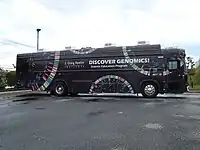J. Craig Venter Institute
32.869107°N 117.243037°W The J. Craig Venter Institute (JCVI) is a non-profit genomics research institute founded by J. Craig Venter, Ph.D. in October 2006. The institute was the result of consolidating four organizations: the Center for the Advancement of Genomics, The Institute for Genomic Research (TIGR), the Institute for Biological Energy Alternatives, and the J. Craig Venter Science Foundation Joint Technology Center. It has facilities in Rockville, Maryland and San Diego, California.
The institute studies the societal implications of genomics in addition to genomics itself. The institute's research involves genomic medicine; environmental genomic analysis; clean energy; synthetic biology; and ethics, law, and economics. The institute employs over 200 people, including Nobel laureate Hamilton Smith. It was sold to the University of California, San Diego, in 2022.
History
In 2004, the Center for the Advancement of Genomics (TCAG), the Institute for Biological Energy Alternatives (IBEA) and the J. Craig Venter Institute Joint Technology Center (JTC) were merged and to form the J. Craig Venter Institute (JCVI).[1]
In 1992, Craig Venter was a researcher at the National Institutes of Health (NIH). He began The Institute for Genomic Research (TIGR) during the same time and was part of the determination of the human genome.[2][3][4] Because of disagreements of how the project was being managed TIGR was excluded from the funding by NIH in 1998.[5][6] The political, personal, and ethical conflicts of the race between the public and private sectors have been notable.[2][3][4][7][8][9][10][11][12]
In 1995, the precursor to the J. Craig Venter Institute, TIGR, determined the sequence of Haemophilus influenzae, Mycoplasma genitalium, and Methanococcus jannaschii.[13][14] In 1997, TIGR determined the genome of Borrelia burgdorferi (which causes Lyme Disease) .[15] In 1998, TIGR sequenced the genome of Treponema pallidum (which causes syphilis).[16] In 1999 TIGR published the sequence of the radioresistant polyextremophile Deinococcus radiodurans.[17] TIGR has sequenced and analyzed more than 50 microbial genomes. TIGR developed the gene finder GLIMMER and the sequence alignment program MUMmer. In 2001 anthrax attacks, TIGR worked with the National Science Foundation and the FBI to sequence the strain of Bacillus anthracis used in bioterrorism attacks.[18]
In June 2000, Venter founded The Center for the Advancement of Genomics (TCAG), a think tank for studying the ethics of human genetics and stem cells research.[19][20]
Also in 2002, Venter founded the Institute for Biological Energy Alternatives (IBEA) to investigate the use of microorganisms to produce alternate fuels (such as hydrogen) and to sequester carbon dioxide.[19] The IBEA began genomic sequencing of environmental microbial populations that might be used.[21] To provide support for these facilities, Venter created the J. Craig Venter Institute Joint Technology Center (JTC), which specialized in high throughput sequencing. To provide administrative and financial support for TIGR, TCAG, IBEA and JTC, Venter created the non-profit J. Craig Venter Science Foundation (JCVSF) to consolidate activities between its affiliated organizations.
In 2007, the institute published the first diploid human genome, i.e. the genome of a single individual (J. Craig Venter) in which both sets of chromosomes were sequenced.[22] In 2010, the institute determined the 1.08 million base pair Mycoplasma mycoides genome, which was then inserted into a cell to create the first cell with a completely synthetic genome.[23]
In April 2022 Venter sold the La Jolla facility to the University of California, San Diego for $25 million. The university, which already has a very strong genomics program, hopes to absorb most of the institute's faculty and its current research grants. Venter will continue to lead a separate nonprofit research group, also known as the J. Craig Venter Institute.[24]
See also
References
- "J. Craig Venter Announces Consolidation of Three Research Organizations Into One New Not-For-Profit Organization — The J.Craig Venter Institute" (Press release). J. Craig Venter Institute. 29 September 2004. Retrieved 20 March 2012.
- Shreeve, James (2004). The Genome War: How Craig Venter Tried to Capture the Code of Life and Save the World. Knopf. ISBN 0375406298.
- Sulston, John (2002). The Common Thread: A Story of Science, Politics, Ethics and the Human Genome. Joseph Henry Press. ISBN 0309084091.
- "The Human Genome Project Race". Center for Biomolecular Science & Engineering, UC Santa Cruz. Retrieved 20 March 2012.
- Pruitt, Kim D. (1998). "WebWise: Guide to The Institute for Genomic Research Web Site". Genome Research. 8 (10): 1000–1004. doi:10.1101/gr.8.10.1000. PMID 9799788. Retrieved 20 March 2012.
- Pennisi, E. (1998). "HUMAN GENOME PROJECT:A Planned Boost for Genome Sequencing, but the Plan is in Flux". Science. 281 (5374): 148–149. doi:10.1126/science.281.5374.148. PMID 9687268. S2CID 40799090.
- Goozner, Merrill (19 December 2001). "Patenting Life". The American Prospect. Retrieved 20 March 2012.
- McElheny, Victor K. (2010). Drawing the Map of Life: Inside the Human Genome Project. Basic Books. ISBN 978-0465043330.
- Venter, J. Craig (2007). A Life Decoded: My Genome: My Life. Viking Adult. ISBN 978-0670063581.
- Rabinow, Paul; Dan-Cohen, Talia (2004). A Machine to Make a Future: Biotech Chronicles. Princeton University Press. ISBN 0691126143.
- Shreeve, James (August 2004). "Craig Venter's Epic Voyage to Redefine the Origin of the Species". Wired. Vol. 12, no. 8. Retrieved 20 March 2012.
- Wade, Nicholas (27 June 2000). "Double Landmarks for Watson: Helix and Genome". The New York Times. Retrieved 20 March 2012.
- Fraser, C. M.; Gocayne, J. D.; White, O.; Adams, M. D.; Clayton, R. A.; Fleischmann, R. D.; Bult, C. J.; Kerlavage, A. R.; Sutton, G.; Kelley, J. M.; Fritchman, J. L.; Weidman, J. F.; Small, K. V.; Sandusky, M.; Fuhrmann, J.; Nguyen, D.; Utterback, T. R.; Saudek, D. M.; Phillips, C. A.; Merrick, J. M.; Tomb, J. -F.; Dougherty, B. A.; Bott, K. F.; Hu, P. -C.; Lucier, T. S.; Peterson, S. N.; Smith, H. O.; Hutchison III, C. A.; Venter, J. C. (1995). "The minimal gene complement of Mycoplasma genitalium". Science. 270 (5235): 397–403. Bibcode:1995Sci...270..397F. doi:10.1126/science.270.5235.397. PMID 7569993. S2CID 29825758.
- Bult, C. J.; White, O.; Olsen, G. J.; Zhou, L.; Fleischmann, R. D.; Sutton, G. G.; Blake, J. A.; Fitzgerald, L. M.; Clayton, R. A.; Gocayne, J. D.; Kerlavage, A. R.; Dougherty, B. A.; Tomb, J. -F.; Adams, M. D.; Reich, C. I.; Overbeek, R.; Kirkness, E. F.; Weinstock, K. G.; Merrick, J. M.; Glodek, A.; Scott, J. L.; Geoghagen, N. S. M.; Venter, J. F.; Fuhrmann, J. L.; Nguyen, D.; Utterback, T. R.; Kelley, J. M.; Peterson, J. D.; Sadow, P. W.; Hanna, M. C. (1996). "Complete genome sequence of the methanogenic archaeon, Methanococcus jannaschii". Science. 273 (5278): 1058–1073. Bibcode:1996Sci...273.1058B. doi:10.1126/science.273.5278.1058. PMID 8688087. S2CID 41481616.
- Fraser, C. M.; Casjens, S.; Huang, W. M.; Sutton, G. G.; Clayton, R.; Lathigra, R.; White, O.; Ketchum, K. A.; Dodson, R.; Hickey, E. K.; Gwinn, M.; Dougherty, B.; Tomb, J. F.; Fleischmann, R. D.; Richardson, D.; Peterson, J.; Kerlavage, A. R.; Quackenbush, J.; Salzberg, S.; Hanson, M.; Van Vugt, R.; Palmer, N.; Adams, M. D.; Gocayne, J.; Weidman, J.; Utterback, T.; Watthey, L.; McDonald, L.; Artiach, P.; Bowman, C. (1997). "Genomic sequence of a Lyme disease spirochaete, Borrelia burgdorferi". Nature. 390 (6660): 580–586. Bibcode:1997Natur.390..580F. doi:10.1038/37551. PMID 9403685. S2CID 4388492.
- Fraser, C. M.; Norris, S. J.; Weinstock, G. M.; White, O.; Sutton, G. G.; Dodson, R.; Gwinn, M.; Hickey, E. K.; Clayton, R.; Ketchum, K. A.; Sodergren, E.; Hardham, J. M.; McLeod, M. P.; Salzberg, S.; Peterson, J.; Khalak, H.; Richardson, D.; Howell, J. K.; Chidambaram, M.; Utterback, T.; McDonald, L.; Artiach, P.; Bowman, C.; Cotton, M. D.; Fujii, C.; Garland, S.; Hatch, B.; Horst, K.; Roberts, K.; Sandusky, M. (1998). "Complete genome sequence of Treponema pallidum, the syphilis spirochete". Science. 281 (5375): 375–388. Bibcode:1998Sci...281..375F. doi:10.1126/science.281.5375.375. PMID 9665876.
- White, O.; Eisen, J.; Heidelberg, J.; Hickey, E.; Peterson, J.; Dodson, R.; Haft, D.; Gwinn, M.; Nelson, W.; Richardson, D. L.; Moffat, K. S.; Qin, H.; Jiang, L.; Pamphile, W.; Crosby, M.; Shen, M.; Vamathevan, J. J.; Lam, P.; McDonald, L.; Utterback, T.; Zalewski, C.; Makarova, K. S.; Aravind, L.; Daly, M. J.; Minton, K. W.; Fleischmann, R. D.; Ketchum, K. A.; Nelson, K. E.; Salzberg, S.; Smith, H. O. (1999). "Genome sequence of the radioresistant bacterium Deinococcus radiodurans R1". Science. 286 (5444): 1571–1577. doi:10.1126/science.286.5444.1571. PMC 4147723. PMID 10567266.
- Read, T. D.; Salzberg, S.; Pop, M.; Shumway, M.; Umayam, L.; Jiang, L.; Holtzapple, E.; Busch, J.; Smith, K.; Schupp, J. M.; Solomon, D.; Keim, P.; Fraser, C. M. (2002). "Comparative Genome Sequencing for Discovery of Novel Polymorphisms in Bacillus anthracis". Science. 296 (5575): 2028–2033. Bibcode:2002Sci...296.2028R. doi:10.1126/science.1071837. PMID 12004073. S2CID 15470665.
- "Genome giant's next step". Prisma Techniek. Retrieved 20 March 2012.
- "Genome News Network". Retrieved 20 March 2012.
- Smith, H. O.; Friedman, R; Venter, J. Craig (Summer 2003). "Biological Solutions to Renewable Energy". The Bridge. 33 (2). Retrieved 20 March 2012.
- Levy, S.; Sutton, G.; Ng, P. C.; Feuk, L.; Halpern, A. L.; Walenz, B. P.; Axelrod, N.; Huang, J.; Kirkness, E. F.; Denisov, G.; Lin, Y.; MacDonald, J. R.; Pang, A. W. C.; Shago, M.; Stockwell, T. B.; Tsiamouri, A.; Bafna, V.; Bansal, V.; Kravitz, S. A.; Busam, D. A.; Beeson, K. Y.; McIntosh, T. C.; Remington, K. A.; Abril, J. F.; Gill, J.; Borman, J.; Rogers, Y. H.; Frazier, M. E.; Scherer, S. W.; Strausberg, R. L. (2007). "The Diploid Genome Sequence of an Individual Human". PLOS Biology. 5 (10): e254. doi:10.1371/journal.pbio.0050254. PMC 1964779. PMID 17803354.
- Gibson, D.; Glass, J.; Lartigue, C.; Noskov, V.; Chuang, R.; Algire, M.; Benders, G.; Montague, M.; Ma, L.; Moodie, M. M.; Merryman, C.; Vashee, S.; Krishnakumar, R.; Assad-Garcia, N.; Andrews-Pfannkoch, C.; Denisova, E. A.; Young, L.; Qi, Z. -Q.; Segall-Shapiro, T. H.; Calvey, C. H.; Parmar, P. P.; Hutchison Ca, C. A.; Smith, H. O.; Venter, J. C. (2010). "Creation of a Bacterial Cell Controlled by a Chemically Synthesized Genome". Science. 329 (5987): 52–56. Bibcode:2010Sci...329...52G. doi:10.1126/science.1190719. PMID 20488990.
- Robbins, Gary (April 27, 2022). "Geneticist Craig Venter sells his La Jolla research center to UC San Diego for $25 million". San Diego Union Tribune. Retrieved 28 April 2022.

